Sought for comment, an official of the Rizal Provincial Hospital
System - Antipolo Annex 1, who asked not to be named, insisted that
the hospital followed breastfeeding protocols. But Pia weighed below
the 2.5-kilogram birth weight threshold and showed signs of sepsis,
the official said.
The formula milk prescribed to Pia met the baby’s caloric
requirements, which might not be sustained by breastfeeding, the
official said.
But with no income, it was
impossible to buy the 400-gram can of milk, which costs P641.
Maryjoy’s common-law husband, Ricky, lost his construction job
because of the pandemic, while Pia’s parents were unemployed
teenagers.
While some local leaders
were aware of the plight of new mothers like Hazel, the Milk Code
posed an obstacle. Sangguniang Kabataan Chairman Arky Manning of
Barangay San Isidro in Taytay, Rizal learned this the hard way.
The Department of Health (DOH)
gave Manning a memo for violating Executive Order (EO) 51, or the
Milk Code of 1986, by “accepting and distributing milk formula
donations” given to mothers with infants in Taytay in April and May
2020.
Manning explained that it
was part of the “Tulong Kay Baby” (help for baby) project, a
donation drive that he had organized with his friends. They bought
milk and diapers using funds given by private individuals. No mass
distribution or random donation of milk happened, he claimed.
Manning was one of the 291
violators flagged by the DOH from March 1 to July 24, largely
covering the ECQ period in Luzon. Reports of violations came from
the general public, submitted through http://mbfp.doh.gov.ph. MBFP,
which stands for DOH’s Mother and Baby-Friendly Philippines, is the
reporting platform for violations of the Milk Code and the Expanded
Breastfeeding Act of 2009 (Republic Act 10028).
The list of violators
included health workers, non-profit organizations, and local
executives such as Manning, and Mayors Andrea Henares of Antipolo
City and Marcy Teodoro of Marikina City. Also on the list were
celebrities such as Say Alonzo and Marian Rivera Dantes, who
together with Nido, a brand that Dantes endorses, and the YesPinoy
Foundation, were reported to have distributed follow-on formula.
Dantes even posted it on Instagram to her 9.4 million followers.
EO 51 issued by former
President Corazon C. Aquino, otherwise known as the Philippine Milk
Code of 1986 or simply, the Milk Code, regulates the marketing of
breastmilk substitutes, including milk formula, breastmilk
supplements and other similar products by prohibiting the
advertising and promotion, whether written, audio or visual, for
such products. It adheres to the International Code on Marketing of
Breastmilk Substitutes, adopted by the World Health Assembly in May
1981. Breastfeeding advocates have hailed the Milk Code as one of
the strongest breastfeeding protection laws in the world.
The Milk Code’s Revised
Implementing Rules and Regulations (RIRR), released 30 years after
the law was signed, prohibits the donation of infant formula and
breastmilk. Administrative orders from the DOH and the Department of
the Interior and Local Government (DILG) further disallow the
donation of infant formula milk and breastmilk substitutes in times
of disasters and calamities.
According to data from the
Food and Nutrition Research Institute, exclusive breastfeeding rates
have continuously gone up in the last 10 years, reaching 57.9
percent in 2019. The global exclusive breastfeeding rate stands at
41 percent. The United Nations targets to increase global
breastfeeding rates to 50 percent by 2025.
Marketing is prohibited, the milk is not
Health Undersecretary
Maria Rosario Vergeire said the law did not bar local government
units (LGUs) from procuring formula milk.
“If local government units
procure formula milk, the law does not cover it. EO 51 is a
regulatory tool used by the Department of Health to regulate the
advertisement of manufacturers that formula milk is more important
than a mother’s milk. That’s our first objective -- we would like to
know that breastmilk is still the best for babies,” she said.
DOH Memorandum No.
2020-0231, dated May 15, 2020, laid down the guidelines on the
standardized regulation of donations covered by the Milk Code.
Formula milk and breastmilk substitutes can still be provided to
those in need, with the following conditions:
1. The local government
unit buys it using its own budget (procurement);
2. Breastmilk should still
be the first choice and the procured formula milk is given to
identified mothers/infants, not distributed en masse;
3. Distribution,
preparation and use of breastmilk substitute and formula milk must
be done under the supervision of health and nutrition workers;
4. There should be no
brand name, logo or identifiable marks of the manufacturer; and
5. No public relations,
announcement or the likes may occur.
Dr. Mianne Silvestre,
executive director of Kalusugan ng Mag-Ina (mother’s health)
Foundation, echoed Vergeire’s explanation.
“The Milk Code is there to
regulate the marketing and advertising of formula milk and
breastfeeding substitutes, and not to penalize parents who give
these products to their children,” Silvestre said. “Nobody goes to
jail for feeding formula milk to their babies.”
Sharing a similar view,
Dr. Paul Zambrano, a technical specialist at Alive and Thrive, a
private initiative to reduce child undernutrition by improving
infant and young child feeding practices, said: “Marketing (of
formula milk and breastmilk substitutes) will undermine the practice
of breastfeeding and complementary feeding with healthy food after
six months. It’s meant to save lives. It is meant to prevent the top
killers of children in that age group – diarrhea and pneumonia. ”
The problem, Silvestre
said, was that formula milk was being marketed as the first option
instead of breastfeeding. This goes against the hierarchy of infant
feeding choices laid out in the Global Strategy for Infant and Young
Child Feeding published by the World Health Organization (WHO),
which states that donated breast milk from a wet nurse or milk bank
takes precedence over formula milk.
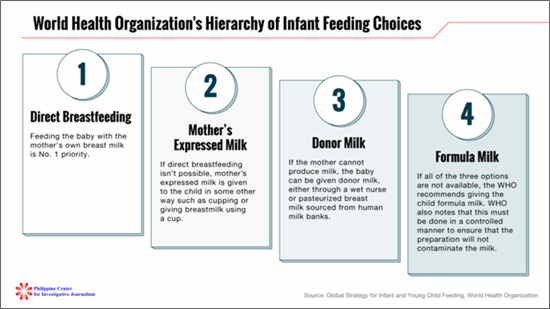
Even for Covid-19 positive
mothers, the WHO still recommends continued breastfeeding and
rooming of babies with their mothers. Transmission of Covid-19
through breastmilk or breastfeeding has not been established.
No guidance for LGUs
What can and cannot be
done under the code does not seem to be clear to local governments,
even to the DILG. In an interview with PCIJ, Interior Undersecretary
Jonathan Malaya, affirmed that the ban extends to selective
distribution of milk to identified mothers and babies and referred
to the National Nutrition Council website for guiding policies.
Taytay’s Manning said no
guidance came from any government agency, particularly the DOH or
DILG, on how they could respond to the needs of mothers and their
babies.
During the quarantine,
local officials, such as Quezon City Councilor Ariel Inton,
repeatedly appealed to the DOH to lift the ban on milk donations.
In a Facebook livestream,
Inton, a lawyer, gave practical advice to barangay officials
planning to distribute formula milk to their constituents. “Tell
them that you are handing it out as loans or ask for coins so they
won’t say it’s a donation, so you can give the children something to
eat,” Inton said.
For Ynares, while the Milk
Code has an important purpose, it can also be a “bane during
crisis.”
“It poses a huge challenge
for families and the government to provide essential nutrition
required for child growth and development particularly during
extraordinary times,” the Antipolo City mayor said.
A National Nutrition
Council advisory said that LGUs should consider that some recipients
of pandemic relief goods have young children and pregnant and
lactating mothers. Families are supposed to be monitored by Barangay
Nutrition Scholars and Barangay Health Workers, who will provide
them with low-cost, one dish-meal recipes as well as recipes
utilizing their relief goods.
But Maryjoy said there
were no vegetables and nutritious food in their relief packs. The
lack of proper nutrition may have affected her daughter Hazel’s milk
supply, she said.
“The first relief pack we
received had three kilos of rice, two cans of sardines, and two
Lucky Me noodles,” she said.
There was one instance,
Maryjoy said, when her family received a few kilos of rice and 16
pieces of dried fish (tuyo). To increase Hazel’s milk, Maryjoy
bought malunggay and cooked it with noodle soup.
While the DOH had
specifically instructed that assistance should be provided to
breastfeeding mothers, Maryjoy said no one from her barangay came to
ask how her daughter and granddaughter were doing. “They only gave
me a 150-gram pack of powdered Bear Brand milk, only for her to
drink, but none for the baby,” Maryjoy recalled.
The usual relief pack
distributed by LGUs during the quarantine period contained a few
kilos of rice, canned goods and instant noodles. The nutrition
council however urged LGUs to include dark green and yellow
vegetables; root crops; legumes, beans and seeds; fruits; poultry
and eggs; meat or fish; and pasteurized fresh milk.
Only a few cities and
municipalities were able to distribute fresh produce.
|
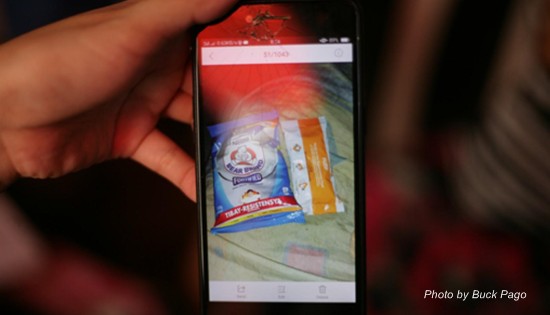
Maryjoy
shows the 150-gram pack of powdered milk she received after
lining up at the barangay hall. She believes the lack of
nutritious food affected Hazel's (not her real name) milk
supply. |
“We are in a crisis
situation, and even the government’s hands are tied because of
supply chain problems. The local government units have to procure
thousands and thousands of produce to give to their constituents who
need it not now, but yesterday. That is the limitation, and we
understand when canned goods are distributed given the situation,”
said DILG’s Malaya.
Malaya pointed out that on
top of the relief packs given to households, a one-time cash
assistance was given in the form of the Social Amelioration Program
(SAP).
“The family can go to the
market and buy what they think is nutritious food for lactating
mothers. The government has already provided funds for them and they
can make that choice if they wish to,” Malaya said.
But for Maryjoy, the SAP
she received had to be divided among three households.
“The P6,500 is to be
divided among three families, with each receiving P2,000, but I get
to have the extra P500 because it was I who lined up for that
money,” Maryjoy said. Most of what she got eventually went to
repaying debt incurred when her husband lost his job.
Milking disasters
Breast or bottle? This
question remains contentious. Since the Milk Code was enacted in
1986, the milk industry has taken advantage of every possible
loophole to undermine the law. When the Milk Code took effect in
1987, international milk manufacturing company Wyeth invented the
follow-on formula for babies six months old and beyond.
The Milk Code’s
implementing rules and regulations (IRR) were revised to include a
ban on advertising follow-on formula in 1990. A revised IRR was
drafted in 2006, adding further safeguards 30 years after the Milk
Code was signed, but this was challenged all the way to the Supreme
Court.
A report released in May
2020 by WHO, United Nations Children’s Fund and the International
Baby Food Action Network said that despite the pandemic, milk
companies continued to skirt laws in many countries and continuously
promoted their products.
“There is no guarantee
that these donations will occur over the long term,” said Dr.
Nathalie Africa-Verceles, director of the University of the
Philippines Center for Women’s and Gender Studies. “The intention
really is to introduce the product and to generate dependence with
the belief and the hope that women will continue to patronize the
products that they were provided for free initially.”
Studies have shown that
mothers exposed to breastmilk substitutes were highly likely to
abandon breastfeeding, and the indiscriminate distribution and use
of formula milk put infants at greater risk of illness, which might
be fatal.
A study in Indonesia in
the aftermath of the May 2006 earthquake in Yogyakarta and Central
Java found that the distribution and use of breastmilk substitutes
resulted in changes in feeding practices. Uncontrolled distribution
of infant formula exacerbated the risk of diarrhea among infants and
young children during the emergency, the study found.
“(The Milk Code) is very
relevant because let’s look at what the companies do during times of
emergencies, they use it to try to market the product,” said
Zambrano.
DOH data confirmed these
observations. The health department noted that a rise in reports of
Milk Code violations from the public began to occur in the week when
the strict lockdowns began, peaking during the week of April 6 to 12
with 90 cases.
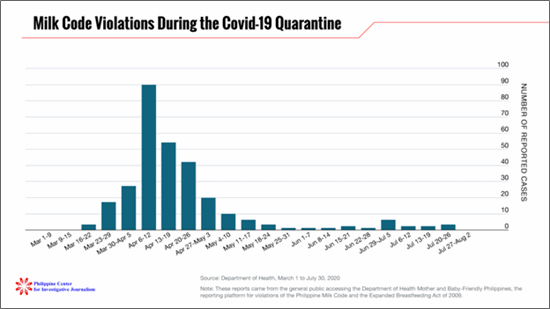
Apart from solicitations,
there were product advertisements, such as Marian Rivera-Dantes’
Instagram post. Corporate and private donations also happened
online, mostly through Facebook posts, according to the DOH data.
Zambrano pointed out that
the relevance of the Code had always been questioned during
emergencies. He recalled a situation in Cagayan de Oro after typhoon
Sendong in 2011 when distribution of formula milk became rampant.
Silvestre downplayed the
matter and said only a few mothers were unable to breastfeed their
babies due to medical or physical reasons.
“These few cases are being
hyped up to rationalize the lifting of the prohibition during
emergencies. When in fact, it is during emergencies when we should
intensify the protection of mothers to enable them to breastfeed
their babies,” Silvestre said.
Formula milk manufacturers
have been accused several times of unscrupulous means of advertising
their products, targeting mostly low-income families or those who
can least afford their product.
A 2018 report from Save
the Children Philippines revealed that baby formula brands in the
Philippines are using “aggressive, clandestine and often illegal
methods” to get poor mothers to choose their product over
breastfeeding.
Hospital staff also gave
brand-specific recommendations to mothers who had just given birth,
clearly a violation of the Milk Code. The report named Nestle,
Abbott, Mead Johnson and Wyeth as the companies who are using these
illegal tactics.
All four companies denied
the allegations in separate statements sent to the Guardian in 2018.
Cheapest, but not the best
Hazel is helping her
mother with their online selling business, earning a few extra pesos
to help augment their family’s income. She expects breastfeeding to
be temporary and will likely go back to feeding Pia formula milk.
Maryjoy said they had
begun feeding Nestogen One to Pia, the cheapest in the market at P78
per box. It wasn’t prescribed by the doctor.
“But Pia doesn’t want it,
she won’t swallow it,” Maryjoy said.
As Hazel handles
deliveries and client meet-ups for their online selling business,
Maryjoy has no choice but to give Pia formula milk.
“I need to go back to
school,” Hazel said.
Asked where they will get
the money to buy formula milk, Hazel shrugged. -- PCIJ,
October 2020
Editor’s Note: The real names of Hazel and her baby, Pia, were not
used because they are minors.
|
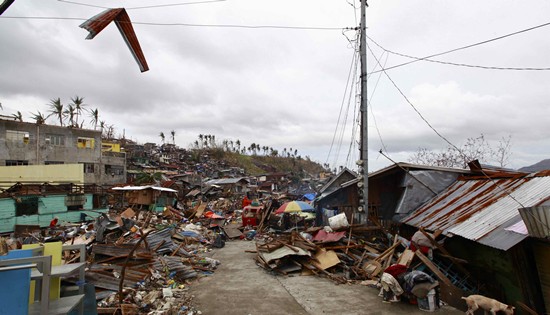
A
piece of GI sheet is seen on top of an electrical post in
Barangay Sagkahan, Tacloban City after Typhoon Yolanda made
landfall and claimed more than 6,000 lives.
(Photo by
Bernard Testa) |
Heavy cost of coronavirus
response drains local governments’ disaster budgets
By
ESTRELLA TORRES
Philippine Center for Investigative Journalism
September 3, 2020
MANILA – The coastal towns of
Dolores and Sulat in Eastern Samar constantly battle with the impact
of extreme weather events such as storm surges, flash floods and
typhoons.
Early this year, the leaders of the two towns were set to conduct
training for emergency response teams, buy rescue equipment and
early warning devices from their calamity funds, but the Covid-19
pandemic got in the way and wiped out their calamity funds to
prevent the entry of the virus.
“The province was not ready to have a Covid-19 case,” said Manuel
Catuday, head of Municipal Disaster Risk Resilience Management
Office (MDRRMO) of Dolores. “We don’t have a government hospital,
only a rural health center with one doctor.”
A community hospital in Dolores has been dilapidated since last
year, and has not been repaired, he said. The next government
hospital is in Tacloban City, which is at least a four-hour drive.
Covid-19 came at a time when the localities have not even completely
recovered from the onslaught of Typhoons Yolanda and Ruby, which
struck a year apart.
While the government was still on post-Yolanda operations, Ruby came
in November 2014 and caused severe damage to homes, crops and
farmlands that were still being rehabilitated. There was not enough
public attention in the aftermath of Ruby as Yolanda was still fresh
in the minds of government officials as well as the general public.
“Lahat ng hanapbuhay namin nawala (All our sources of livelihood
were destroyed),” said Rio Caspe, 42, a fisherman from Barangay San
Francisco in Sulat whose house was destroyed by Typhoon Ruby.
His three children and wife had to rely on the meager earnings of
their small sari-sari store as massive flooding made fishing
difficult.
Caspe said his neighbors were also cash-strapped because their crops
such as banana, rice and copra were destroyed by the typhoon.
“We only relied on relief goods while staying in an evacuation
center,” said Caspe.
Funds depleted
Dolores, a third-class municipality, earmarked P8 million in
calamity funding for 2020 to prepare and protect its 42,000 people
or 12,700 families from the impact of natural calamities.
However, the funds had to be realigned to buy personal protective
equipment (PPE) for community volunteers as well as hygiene kits and
food packs for residents during the lockdown, which was imposed to
prevent the spread of Covid-19. The national government’s Bayanihan
fund gave Dolores a P14-million subsidy to respond to the Covid-19
pandemic.
“We are now sourcing from this (Bayanihan) fund for our response to
Covid-19 pandemic,” said Catuday.
The town also has to spend for at least 900 LSIs or locally stranded
individuals who arrived in Dolores from March to June.
Dolores, Sulat, and seven other towns in Samar were placed under
state of calamity in May when Typhoon Ambo, the first typhoon to
visit the country this year, pummeled the province. As usual, the
storm destroyed crops and damaged houses, displacing more than
140,000 people.
Most houses in these towns are made of light materials.
“Matagal bago kami makabangon, hirap kasi ang pagpapagawa (It takes
a long time to recover because we don’t have enough money to repair
our houses),” said Catuday.
Charlie Rosaroso, head of the Sulat MDRRMO, said at least P1.5
million or 30 percent of the P5.1 million calamity fund for 2020 was
spent to provide emergency assistance to families affected by
Typhoon Ambo. The remaining funds were depleted by the Covid-19
response.
He said he was only able to spare P300,000 to continue the training
for volunteers on emergency response.
Provinces and cities get 5 percent of the Internal Revenue Allotment
(IRA), the local governments’ share of national tax collections, for
disaster risk resilience (DRR) under Republic Act 10121 or the
Philippine Disaster Risk Reduction and Management Act of 2010.
Of the total calamity fund, 70 percent is allocated to prevention,
mitigation and preparedness, and 30 percent is set aside as a Quick
Response Fund (QRF).
“What is left of our calamity fund is now being used for our
Covid-19 response,” said Rosaroso. These include relief goods, PPE
for volunteers, hygiene kits, food packs for residents, as well as
LSIs and ROFs (returning overseas Filipinos) undergoing quarantine.
Sulat has hosted close to 200 LSIs since March.
A fourth-class municipality with a population of close to 16,000,
Sulat does not have a hospital, but there is one doctor in each of
the rural health centers in 18 barangays, said Rosaroso.
As of Aug. 10, there were eight confirmed cases of Covid-19
infection in Eastern Samar and most of them came from Metro Manila.
Both Catuday and Rosaroso said there were no confirmed cases in
their towns, as they work even on Sundays to ensure health and
hygiene protocols are properly implemented.
Mario Candelaria, chairman of Barangay San Francisco in Sulat, said:
“An infection here is a nightmare because we don’t have a hospital.”
“Noon 'pag galing Maynila sinasalubong ng mga taga dito, ngayon
nilalayuan na (Before, those who arrived from Manila got a welcome,
now people avoid them,” said Candelaria.
He said the P110,000 calamity fund of San Francisco has also been
used for food packs, hygiene kits, and for disinfecting public
facilities.
Exposed and vulnerable
The Philippines ranked second in terms of exposure and vulnerability
to climate-related risks in the Global Climate Change Risk Report
for 2020 of Germanwatch, the environment think tank. Japan topped
the list.
Red Constantino, executive director of the Institute for Climate and
Sustainable Cities (ICSC), said the report showed that "Those who
are least responsible for the problem, are the ones who are
suffering the most. This is unacceptable."
“The pandemic has largely revealed systemic weaknesses that would
have just taken more time to uncover otherwise,” said Constantino.
The German report noted that strong tropical cyclones such as Bopha
(“Pablo”) 2012, Haiyan (“Yolanda”) 2013 and Mangkhut (“Ompong”) 2018
have been recorded in the last 10 years, affecting mostly the poor
and vulnerable population.
At least 74 percent of the country’s population is susceptible to
multiple hazards, including coastal hazards such as typhoons, storm
surges and rising sea levels, according to the 2018 World Risk
Report. The report ranked the Philippines third among countries most
vulnerable to disaster risks.
The catastrophic impact of Tropical Depression Ondoy in 2009 cost
Marikina and Pasig cities P22.54 billion, of which Pasig accounted
for 90 percent.
Rich city gets more money
This time around, Pasig City had to let go of critical spending for
disaster risk resilience programs due to the pandemic response, said
Bryant Wong, the city disaster risk reduction and management
officer. These included reducing the number of fire engines and
rescue vehicles to be purchased.
“We did not expect Covid-19 pandemic to affect us all, but we need
to respond to it the best way we can,” Wong said.
Unlike Sulat and Dolores, however, Pasig City Hall has deeper
pockets and generous donors.
Of the P600-million calamity fund for 2020, the city government has
spent half for the Covid-19 pandemic response, Wong said.
It also managed to utilize an additional P200 million from the P300
million DRR savings in the last five years.
Other funding sources for Pasig City’s Covid-19 response included a
P1.2-billion supplemental fund for the Social Amelioration Program
(SAP) and another P1.2 billion for tablets to be used by students
for online classes, from the Special Education Fund.
The city also received P136 million from the Bayanihan fund,
equivalent to one month of its IRA.
Wong said private donations of beds, PPEs, hygiene kits and rapid
testing kits worth P50 million boosted the city’s pandemic response.
The private sector also donated 100,000 food packs to Pasig.
In the case of Sulat and Dolores towns, there are no big corporate
donors, which meant that the money for food packs distributed to
locked-down residents came from their calamity funds.
Funding sources
Undersecretary Ricardo Jalad of the Office of Civil Defense, also
the executive director of the National Disaster Risk Reduction and
Management Council Council (NDRRMC), told local government units (LGUs)
in a webinar in July to learn “to adjust, transform and adapt
strategies to manage response to Covid-19 pandemic and prepare for
multiple hazards from natural calamities.”
During the webinar, John Aries Macaspac, a director of the
Department of Budget and Management (DBM), enumerated funding
sources for the Covid-19 response, including the Special DRRM Trust
Fund or the savings from DRR funds in the last five years, a month’s
worth of IRA from the national government and realigned funds from
the General Fund. LGUs may also use 20 percent of their development
funds for the purchase of PPEs, rapid test kits, vitamins,
medicines, accommodation and expenses of health workers,
construction of rental quarantine facilities, mobile testing labs,
tents, shelters for the homeless, and training for pandemic
response, under guidelines issued by the DBM and the Department of
the Interior and Local Government (DILG).
The “Bayanihan to Heal as One” or Republic Act 11469 allocated P37
billion for the emergency Covid-19 response of LGUs. It allocated
P12.4 billion to all cities; P18.39 billion to municipalities and
P6.2 billion to provinces.
Constantino said responses to the Covid-19 pandemic and climate
emergency should go hand in hand, as both require the expertise of
scientists and policies and actions based on evidence.
Scientists, he noted, advised physical distancing to prevent the
transmission Covid-19 while waiting for a vaccine to be developed.
Scientists have also stressed the urgency of limiting the rise of
global temperatures to below 1.5 degrees Celsius to avoid the worst
impacts of the climate crisis.
“We do not have the luxury to choose whether we need protection from
the deadly fevers induced by the novel coronavirus or from an
increasingly feverish planet. Just as climate change is not an
environmental problem but a development crisis, so is Covid-19 not
merely a human health crisis but an ecological problem,” said
Constantino.
About the Author:
Estrella Torres is a journalist who has worked for major English
dailies in the Philippines for 20 years. She is now the Head of
Media and Communications of Save the Children Philippines. Save the
Children implements a program on improving the quality of disaster
response and preparedness in the typhoon-stricken municipalities of Sulat and Dolores in Eastern Samar.
Todo-Todoc’s
increase amidst the crisis
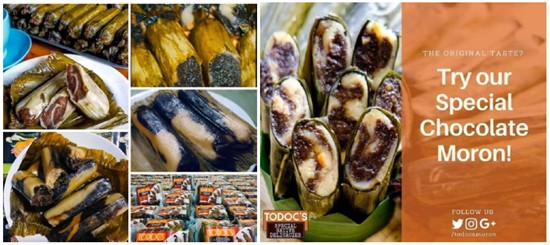
By
DTI-Regional Operations
Group
July 15, 2020
MAKATI CITY – 2020,
is it the best year yet? Well, not for the younger generation. The
recent restrictions on travel and other leisure activities affected
the tourism industry everywhere. Far from happiness, most of Region
8’s micro entrepreneurs who fall under the sector of tourism support
were greatly affected. These are businesses who support the local
tourism by offering a handful of sweet native delicacies.
Leah Hiangnan, a young
traveler and entrepreneur/owner of Todoc’s Special Native
Delicacies, is already experiencing success from her thriving
business selling chocolate moron (chocolate sticky rice pudding). It
is a well-known native delicacy usually introduced and loved by
visiting tourists, and pasalubong from every kababayan in Eastern
Visayas. Her brand- Todoc’s, is known to originate from Abuyog,
Leyte, the true home of this delicacy.
Prior to the threat of the
COVID-19 pandemic, her product was top-selling, she also has
shipments to Manila, Cebu and Bohol.
For Leah, success is on
her side, until recently she experienced unfortunate events in her
life. Her father died this year, then comes the pandemic. Sadly, her
orders for the Holy Week and Summer were cancelled due to low demand
in tourism-support products and logistical concerns.
Everything seems to stop
in her life. “Nahulop ko Maám, asa ko pamilngon an akon ibayad
monthly sa akon loans para sa business operation,” says Leah who
emotionally shared her struggle on how she can pay her loans used to
expand her business when their operations stopped. She also shared
how her family is financially affected by the hiatus, especially
that she gave birth to her first born. Good thing the financial
institutions imposed moratorium for loan payments.
She was also concerned of
the employees who depend their livelihood on hers. Twenty (20) of
her employees instantaneously lost their jobs, and she could not
support them either.
For some time, she paused
and started to think of ways how she can advance forward. She was
determined to move on and learn to navigate the unknown paths of the
“new normal”. With internet and a social media account, she started
posting photos of her product online. It was a positive step, a few
orders came.
Exactly May 1, 2020, she
called out 7-10 employees and started the production of chocolate
moron. They started to work twice a week. Though far from her daily
production and 20 employees working for her, it was a good start.
Soon enough, she will gain back her monthly income of
P80,000-100,000.
Leah noticed that most
orders are coming outside of the region. She searched further and
found out that there is a high demand for native delicacies in
Manila.
Now how would she deliver
her products? Again, through online searching, Leah found a way.
“Pasabay” services are the trend for micro entrepreneurs. Small
logistics player in the region offer door to door delivery of
products from small businesses to their linked businesses in Manila.
“Naghahanap ako Maám ng
paraan para maka-kuha ng orders, mag-produce kami at maka-deliver,”
says Leah who was determined to seize every opportunity of getting
bulk orders outside the region and delivering them.
Talking about disaster
resilience, she is coping with the crisis by establishing a broader
network and strengthening business ties with her partners while
finding ways “paraan/diskarte” to make sure her business goes
running.
Usually she sends her
products in Cebu, Bohol and Manila, now, a door opened for Dumaguete
with an initial order of 60 packs of chocolate moron.
Despite the spiking prices
of raw materials for the production and the limited supply of sugar
and milk, Leah will be producing 12,000 pcs of chocolate moron this
week and expects more to come in succeeding weeks.
Leah will also process the
delicacy in the water retort facility at the Food Innovation Center
by DTI and DOST to extend the shelf life of her product. She
considered the possible delays in logistics, and so, she wanted to
ensure the consistency of her product’s quality.
“I will always find ways
to make sure that our business will always run by building new
business linkages and stepping in for every opportunity I find,”
says Leah Hiangnan with full determination to keep her business at
the middle of a crisis.
◄◄home
I
next►►